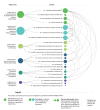Core competencies in applied infectious disease epidemiology: a framework for countries in Europe
- PMID: 36757315
- PMCID: PMC9912377
- DOI: 10.2807/1560-7917.ES.2023.28.6.2200517
Core competencies in applied infectious disease epidemiology: a framework for countries in Europe
Abstract
In 2009, the European Centre for Disease Prevention and Control (ECDC) developed a competency framework to support European Union countries and the European Commission in ensuring a competent public health workforce for Europe. The coronavirus disease (COVID-19) pandemic emphasised the importance of harmonised public health strategies and competencies across international boundaries, specifically for infectious diseases. This perspective presents the process to update the competency framework for applied infectious disease epidemiology, highlighting ECDC's efforts to support countries with using the framework. ECDC commissioned the Association of Schools of Public Health in the European Region (ASPHER) to update the framework through publication and dissemination of a technical report and a self-assessment tool linked to training resources. A mixed methods approach to gather input from experts in relevant specialities included qualitative interviews with 42 experts, workshops with ECDC Technical Advisory Group and an online survey of 212 public health professionals across Europe and beyond. Modifications resulted in 157 core competencies in 23 domains, each mapping to one of six subject areas of importance in applied infectious disease epidemiology. The framework serves as a basis to update the curriculum of the ECDC Fellowship programme with two alternative paths: intervention epidemiology or public health microbiology.
Keywords: ASPHER, European Union, ECDC, workforce; control; core competencies; epidemiology; framework; infectious diseases; prevention; public health; public health expert; self-assessment.
Conflict of interest statement
Figures



References
-
- European Centre for Disease Prevention and Control (ECDC). Core competencies for EU public health epidemiologists in communicable disease surveillance and response. Stockholm: ECDC; 2009. Available from: https://www.ecdc.europa.eu/sites/default/files/media/en/publications/Pub...
MeSH terms
LinkOut - more resources
Full Text Sources
Medical
